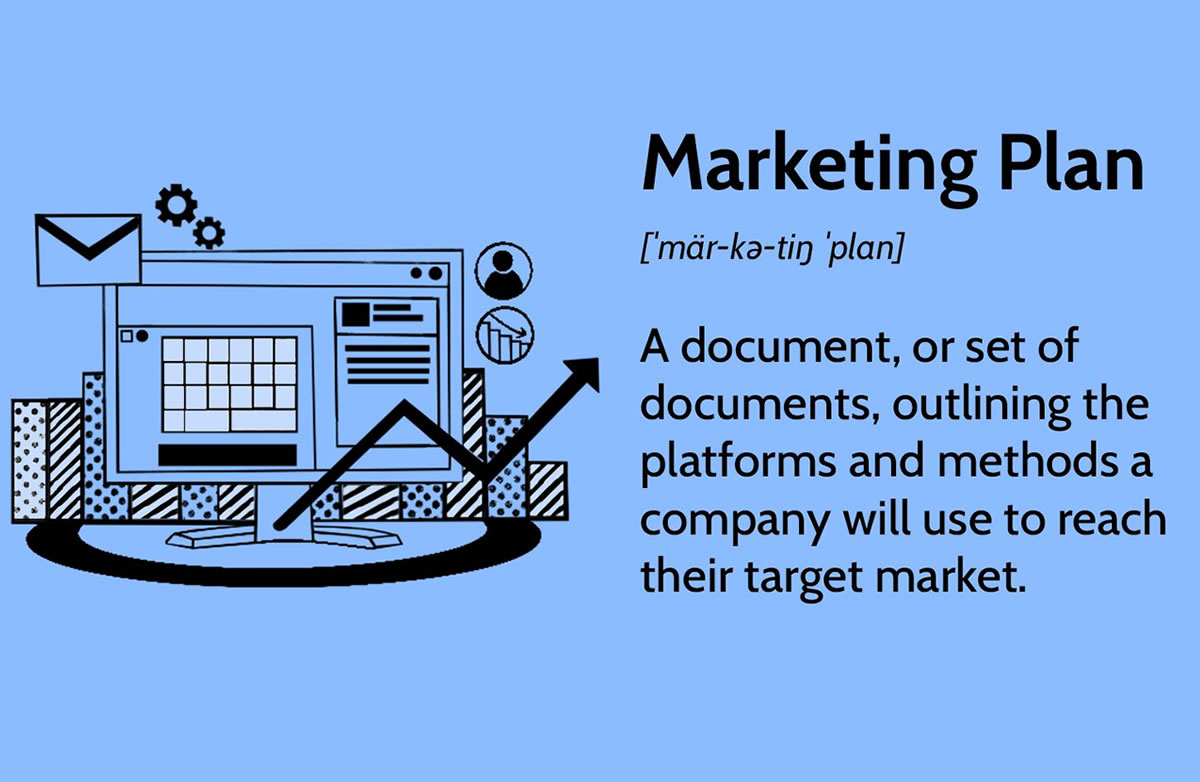
Marketing Plan
A marketing plan is a document that lays out the marketing efforts of a business in an upcoming period, which is usually a year. It outlines the marketing strategy, promotional, and advertising activities planned for the period.
A document that lays out the marketing efforts of a business in an upcoming period!!
Elements of a Marketing Plan
Marketing objectives of the business: The objectives should be attainable and measurable – two goals associated with SMART, which stands for Specific, Measurable, Attainable, Relevant, and Time-bound.
Current business marketing positioning: An analysis of the current state of the organization concerning its marketing positioning.
Market research: Detailed research about current market trends, customer needs, industry sales volumes, and expected direction.
Outline of the business target market: Business target market demographics.
Marketing activities: A list of any actions concerning marketing goals that are scheduled for the period and the indicated timelines.
Key performance indicators (KPIs) to be tracked
Marketing mix: A combination of factors that may influence customers to purchase products. It should be appropriate for the organization and will largely be cantered on the 4Ps of marketing – i.e., product, price, promotion, and place.
Competition: Identify the organization’s competitors and their strategies, along with ways to counter competition and gain market share.
Marketing strategies: The development of marketing strategies to be employed in the coming period. These strategies will include promotional strategies, advertising, and other marketing tools at the disposal of the organization.
Marketing budget: A detailed outline of the organization’s allocation of financial resources to marketing activities. The activities will need to be carried out within the marketing budget.
Monitoring and performance mechanism: A plan should be in place to identify if the marketing tools in place are bearing fruit or need to be revised based on the past, current, and expected future state of the organization, industry, and the overall business environment.
A marketing plan should observe the 80:20 rule – i.e., for maximum impact, it should focus on the 20% of products and services that account for 80% of volumes and the 20% of customers that bring in 80% of revenue.

Purpose of a Marketing Plan
The purpose of a marketing plan includes the following:
- To clearly define the marketing objectives of the business that align with the corporate mission and vision of the organization. The marketing objectives indicate where the organization wishes to be at any specific period in the future.
- The marketing plan usually assists in the growth of the business by stating appropriate marketing strategies, such as plans for increasing the customer base.
- State and review the marketing mix in terms of the 8Ps of marketing – Product, Price, Place, Promotion, People, Process, Physical Evidence, and Performance.
- Strategies to increase market share, enter new niche markets, and increase brand awareness are also encompassed within the marketing plan.
- The marketing plan will contain a detailed budget for the funds and resources required to carry out activities indicated in the marketing plan.
- The assignment of tasks and responsibilities of marketing activities is well enunciated in the marketing plan.

Structure of a Marketing Plan
The structure of a marketing plan can include the following sections:
Marketing Plan Objectives
This section outlines the expected outcome of the marketing plan with clear, concise, realistic, and attainable objectives. It contains specific targets and time frames.
Metrics, such as target market share, the target number of customers to be attained, penetration rate, usage rate, sales volumes targeted, etc. should be used.
Market Research – Market Analysis/Consumer Analysis
Market analysis includes topics such as market definition, market size, industry structure, market share and trends, and competitor analysis. Consumer analysis includes the target market demographics and what influences their buying decisions – e.g., loyalty, motivation, and expectations.
Target Market
This defines the target customers by their demographic profile, such as gender, race, age, and psychographic profile, such as their interests. This will assist in the correct marketing mix for the target market segments.
Marketing Strategy
The marketing strategy section covers actual strategies to be included according to the marketing mix. The strategy centers on the 8Ps of marketing. However, firms are also at liberty to use the traditional 4 P’s of marketing – product, price, place, and promotion.
The correct marketing mix is determined by the target market. The most expensive options are advertising, sales promotions, and PR campaigns. Networking and referrals are less costly.
Marketers also need to pay attention to digital marketing strategies that make use of technology to reach a wider market and have also proven to be cost-effective.
Digital marketing channels, which became popular in the early 21st century, may eventually overtake traditional marketing methods. Digital marketing encompasses trending methods, such as the use of social media for business.
Other strategies within the marketing strategy include pricing and positioning strategy, distribution strategy, conversion strategy, and retention strategy.
Marketing Budget
The marketing budget or projection outlines the budgeted expenditure for the marketing activities documented in the marketing plan. The marketing budget consists of revenues and costs stated in the marketing plan in one document.
It balances expenditures on marketing activities and what the organization can afford. It’s a financial plan of marketing activities to be carried out – e.g., promotional activities, cost of marketing materials and advertising, and so on. Other considerations include expected product volume and price, production and delivery costs, and operating and financing costs.
The effectiveness of the marketing plan depends on the budget allocated for marketing expenditure. The cost of marketing should be able to make the company break even and make profits.
Performance Analysis
Performance analysis aims to look at the variances of metrics or components documented in the marketing plan. These include:
Revenue variance analysis: An analysis of positive or negative variance of revenue. A negative variance is worrisome, and reasons should be available to explain the cause of deviations.
Market share analysis: An analysis of whether the organization attained its target market share. Sales may be increasing whilst the organization’s share of the market is decreasing; hence, it is paramount to track this metric.
Expense analysis: An analysis of marketing expense to sales ratio. This ratio needs to be compared to industry standards to make informed comparisons.
The ratio enables the organization to track actual expenditures versus the budget. It is also compared to other metrics, such as revenue analysis and market share analysis. It can be dissected into individual expenditures to sales to get a clearer picture.
Administration of a Marketing Plan
The marketing plan should be revised and adapted to changes in the environment periodically. The use of metrics, budgets, and schedules to measure progress towards the goals set in the marketing plan is a continuous process by marketing personnel.
There should be a continuous assessment to verify that the goals of the marketing plan are being achieved. The marketing manager should be able to review if the strategies documented are being effective, given the operating environment.
It is irrational for the marketing manager to notice anomalies and wait to review at year-end when the situation might have already deteriorated.
Changes in the environment may necessitate a review of plans, projections, strategies, and targets. Therefore, a formal periodical review – such as monthly or quarterly – may need to be in place. This may mean preparing an annual marketing plan but reviewing the plan quarterly to keep targets and plans aligned closely to environmental changes. It goes without saying that plans are as good as their feasibility to succeed in the given environment.
Author: Safwan Ul Amin (Business Sales Director)
I have over 20 years experience in various business industries. Contact me on 02037332315 or [email protected] if you are thinking about buying or selling a business via our platform.
Sorry, the comment form is closed at this time.



